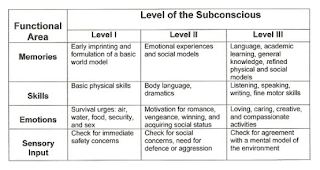 |
| Table #4: Typical functions of the subconscious levels |
Applications of the Four-Part Model
As with any model, the only value of the four-part model of the mind is in helping to organize the known facts and properties, and helping to explain the operation of a complex system. Dividing subconscious activity into three levels is a somewhat arbitrary procedure, perhaps analogous to classifying the flowers in a garden into three height categories. However, there does seem to be a correspondence among the subconscious activities and the physical structures of the hindbrain, midbrain, and forebrain. Similar comments could be made regarding the assignment of distinct memories, skills, emotions, and sensory input to each level of the subconscious.
The three levels of the subconscious, each with four subsections (memories, skills, emotions, sensory input) lead to a total of twelve subsections. The focus of attention of your conscious mind changes constantly during the course of a day as the twelve subsections of your subconscious compete for its attention. Typical functions of the subsections of the subconscious are summarized in Table #4.
As with any model, the only value of the four-part model of the mind is in helping to organize the known facts and properties, and helping to explain the operation of a complex system. Dividing subconscious activity into three levels is a somewhat arbitrary procedure, perhaps analogous to classifying the flowers in a garden into three height categories. However, there does seem to be a correspondence among the subconscious activities and the physical structures of the hindbrain, midbrain, and forebrain. Similar comments could be made regarding the assignment of distinct memories, skills, emotions, and sensory input to each level of the subconscious.
The three levels of the subconscious, each with four subsections (memories, skills, emotions, sensory input) lead to a total of twelve subsections. The focus of attention of your conscious mind changes constantly during the course of a day as the twelve subsections of your subconscious compete for its attention. Typical functions of the subsections of the subconscious are summarized in Table #4.
Priority of interrupts
According to our model of the mind, there are at least twelve sources of information continually competing for the seven information slots available in your immediateterm memory. How can the model deal with such competition?
An analogous situation occurs in the operation of computers. The CPU in a computer hums along at several million cycles per second while it switches back and forth among several subprograms running at the same time. Computers can also be connected to a variety of other devices such as printers, scanners, keyboards, the Internet, and extra memory devices. Often more than one program or device wants the attention of the CPU at the same time. To handle this type of situation, a system of priorities is built into programs and devices, and the CPU is programmed to deal with the highest priority items first.
The mind seems to have an analogous set of priorities: potential hazards are dealt with first, then emotional reactions, and finally analytical thought. When we are in a calm and safe environment, our mental activity flows along in a semi-automatic mode. We are free to analyze and daydream to our heart’s content. But if we step on a sharp object or sniff a foul chemical in the air, those sensations take priority and our attention is snapped back to our immediate environment.
According to our model of the mind, there are at least twelve sources of information continually competing for the seven information slots available in your immediateterm memory. How can the model deal with such competition?
An analogous situation occurs in the operation of computers. The CPU in a computer hums along at several million cycles per second while it switches back and forth among several subprograms running at the same time. Computers can also be connected to a variety of other devices such as printers, scanners, keyboards, the Internet, and extra memory devices. Often more than one program or device wants the attention of the CPU at the same time. To handle this type of situation, a system of priorities is built into programs and devices, and the CPU is programmed to deal with the highest priority items first.
The mind seems to have an analogous set of priorities: potential hazards are dealt with first, then emotional reactions, and finally analytical thought. When we are in a calm and safe environment, our mental activity flows along in a semi-automatic mode. We are free to analyze and daydream to our heart’s content. But if we step on a sharp object or sniff a foul chemical in the air, those sensations take priority and our attention is snapped back to our immediate environment.









